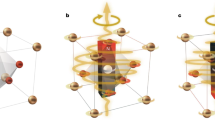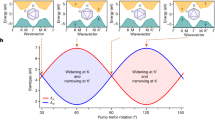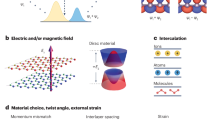Abstract
The locking of the electron spin to the valley degree of freedom in transition metal dichalcogenide (TMD) monolayers has seen these materials emerge as a promising platform in valleytronics1,2. When embedded in optical microcavities, the large oscillator strengths of excitonic transitions in TMDs allow the formation of polaritons that are part-light part-matter quasiparticles3,4,5,6,7. Here, we report that polaritons in MoSe2 show an efficient retention of the valley pseudospin contrasting them with excitons and trions in this material. We find that the degree of the valley pseudospin retention is dependent on the photon, exciton and trion fractions in the polariton states. This allows us to conclude that in the polaritonic regime, cavity-modified exciton relaxation inhibits loss of the valley pseudospin. The valley-addressable exciton-polaritons and trion-polaritons presented here offer robust valley-polarized states with the potential for valleytronic devices based on TMDs embedded in photonic structures and valley-dependent nonlinear polariton–polariton interactions.
This is a preview of subscription content, access via your institution
Access options
Access Nature and 54 other Nature Portfolio journals
Get Nature+, our best-value online-access subscription
$29.99 / 30 days
cancel any time
Subscribe to this journal
Receive 12 print issues and online access
$209.00 per year
only $17.42 per issue
Buy this article
- Purchase on Springer Link
- Instant access to full article PDF
Prices may be subject to local taxes which are calculated during checkout




Similar content being viewed by others
References
Xiao, D., Liu, G.-B., Feng, W., Xu, X. & Yao, W. Coupled spin and valley physics in monolayers of MoS2 and other group-VI dichalcogenides. Phys. Rev. Lett. 108, 196802 (2012).
Mak, K. F., He, K., Shan, J. & Heinz, T. F. Control of valley polarization in monolayer MoS2 by optical helicity. Nat. Nanotech. 7, 494–498 (2012).
Liu, X. et al. Strong light–matter coupling in two-dimensional atomic crystals. Nat. Photon. 9, 30–34 (2015).
Dufferwiel, S. et al. Exciton–polaritons in van der Waals heterostructures embedded in tunable microcavities. Nat. Commun. 6, 8579 (2015).
Flatten, L. C. et al. Room-temperature exciton-polaritons with two-dimensional WS2 . Sci. Rep. 6, 33134 (2016).
Sidler, M. et al. Fermi polaron-polaritons in charge-tunable atomically thin semiconductors. Nat. Phys. 13, 255–261 (2017).
Lundt, N. et al. Room-temperature Tamm-plasmon exciton-polaritons with a WSe2 monolayer. Nat. Commun. 7, 13328 (2016).
Mak, K. F., Lee, C., Hone, J., Shan, J. & Heinz, T. F. Atomically thin MoS2: a new direct-gap semiconductor. Phys. Rev. Lett. 105, 136805 (2010).
Berkelbach, T. C., Hybertsen, M. S. & Reichman, D. R. Theory of neutral and charged excitons in monolayer transition metal dichalcogenides. Phys. Rev. B 88, 045318 (2013).
Ugeda, M. M. et al. Giant bandgap renormalization and excitonic effects in a monolayer transition metal dichalcogenide semiconductor. Nat. Mater. 13, 1091–1095 (2014).
Kasprzak, J. et al. Bose–Einstein condensation of exciton polaritons. Nature 443, 409–414 (2006).
Amo, A. et al. Superfluidity of polaritons in semiconductor microcavities. Nat. Phys. 5, 805–810 (2009).
Amo, A. et al. Exciton–polariton spin switches. Nat. Photon. 4, 361–366 (2010).
Marsault, F. et al. Realization of an all optical exciton-polariton router. Appl. Phys. Lett. 107, 201115 (2015).
Walker, P. M. et al. Ultra-low-power hybrid light–matter solitons. Nat. Commun. 6, 8317 (2015).
Yu, H., Cui, X., Xu, X. & Yao, W. Valley excitons in two-dimensional semiconductors. Natl Sci. Rev. 2, 57–70 (2014).
Maialle, M. Z., de Andrada e Silva, E. A. & Sham, L. J. Exciton spin dynamics in quantum wells. Phys. Rev. B 47, 15776 (1993).
Glazov, M. M. et al. Exciton fine structure and spin decoherence in monolayers of transition metal dichalcogenides. Phys. Rev. B 89, 201302 (2014).
Yu, H., Liu, G.-B., Gong, P., Xu, X. & Yao, W. Dirac cones and Dirac saddle points of bright excitons in monolayer transition metal dichalcogenides. Nat. Commun. 5, 3876 (2014).
Whittaker, D. M. et al. Motional narrowing in semiconductor microcavities. Phys. Rev. Lett. 77, 4792–4795 (1996).
Wang, G. et al. Polarization and time-resolved photoluminescence spectroscopy of excitons in MoSe2 monolayers. Appl. Phys. Lett. 106, 112101 (2015).
Trichet, A. A. P. et al. Topographic control of open-access microcavities at the nanometer scale. Opt. Express 23, 17205–17216 (2015).
Rapaport, R. et al. Negatively charged polaritons in a semiconductor microcavity. Phys. Rev. B 63, 235310 (2001).
Kavokin, A., Malpuech, G. & Glazov, M. Optical spin Hall effect. Phys. Rev. Lett. 95, 136601 (2005).
Dufferwiel, S. et al. Strong exciton-photon coupling in open semiconductor microcavities. Appl. Phys. Lett. 104, 192107 (2014).
Godde, T. et al. Exciton and trion dynamics in atomically thin MoSe2 and WSe2: effect of localization. Phys. Rev. B 94, 165301 (2016).
Moody, G. et al. Intrinsic homogeneous linewidth and broadening mechanisms of excitons in monolayer transition metal dichalcogenides. Nat. Commun. 6, 8315 (2015).
Bleu, O., Solnyshkov, D. & Malpuech, G. Optical valley Hall effect based on transitional metal dichalcogenide cavity polaritons. Preprint at http://arXiv.org/abs/1611.02894 (2016).
Sarkar, D. et al. Polarization bistability and resultant spin rings in semiconductor microcavities. Phys. Rev. Lett. 105, 216402 (2010).
Kretinin, A. V. et al. Electronic properties of graphene encapsulated with different two-dimensional atomic crystals. Nano Lett. 14, 3270–3276 (2014).
Acknowledgements
We thank the financial support of the Graphene Flagship under grant agreement 696656, the Engineering and Physical Sciences Research Council (EPSRC) grants EP/M012727/1 and EP/J007544/1, European Research Council (ERC) Advanced Grant EXCIPOL no. 320570, and Marie Sklodowska-Curie network Spin-NANO under grant agreement 676108. A.A.P.T., D.N.K. and J.M.S. acknowledge support from the Leverhulme Trust. F.W. acknowledges support from the Royal Academy of Engineering, and K.S.N. from the Royal Society, EPSRC, US Army Research Office and ERC Grant Hetero2D.
Author information
Authors and Affiliations
Contributions
S.D, and T.P.L. carried out optical investigations with a contribution from S.S. A.A.P.T. designed and fabricated the concave mirrors. F.W. fabricated the MoSe2 samples. D.D.S. and G.M. carried out theoretical analysis. S.D. analysed the data and prepared the manuscript with contributions from all co-authors. J.M.S., K.S.N., M.S.S., D.N.K. and A.I.T. provided management of various aspects of the project. D.N.K. proposed the idea of using an open-access microcavity system, developed by his group, for polariton studies with TMD monolayers. S.D. and A.I.T. conceived the project. A.I.T. oversaw the project.
Corresponding authors
Ethics declarations
Competing interests
The authors declare no competing financial interests.
Supplementary information
Supplementary information
Supplementary information (PDF 2923 kb)
Rights and permissions
About this article
Cite this article
Dufferwiel, S., Lyons, T., Solnyshkov, D. et al. Valley-addressable polaritons in atomically thin semiconductors. Nature Photon 11, 497–501 (2017). https://doi.org/10.1038/nphoton.2017.125
Received:
Accepted:
Published:
Issue Date:
DOI: https://doi.org/10.1038/nphoton.2017.125
This article is cited by
-
Energy transfer driven brightening of MoS2 by ultrafast polariton relaxation in microcavity MoS2/hBN/WS2 heterostructures
Nature Communications (2024)
-
Ultrafast investigation of room temperature valley polarization in “optical bilayer” WS2
Science China Technological Sciences (2024)
-
Macroscopic transition metal dichalcogenides monolayers with uniformly high optical quality
Nature Communications (2023)
-
Interspecies exciton interactions lead to enhanced nonlinearity of dipolar excitons and polaritons in MoS2 homobilayers
Nature Communications (2023)
-
Revealing broken valley symmetry of quantum emitters in WSe2 with chiral nanocavities
Nature Communications (2023)



